What Makes a Pole Transformer Different from Other Distribution Transformers?
Are you struggling to decide which type of distribution transformer is best for your project? You’re not alone. Many engineers and project managers find themselves confused about the differences between pole-mounted, pad-mounted, and underground transformers. But what if you had a clear guide to help you understand these differences and make the right choice for your specific needs?
Pole transformers are mounted on utility poles and used for overhead power distribution. Unlike pad-mounted or underground transformers, they are more exposed but cheaper to install in rural or semi-urban settings. This guide explains their structural differences and when to use each type. Understanding these distinctions is crucial for optimizing your power distribution system’s efficiency, cost-effectiveness, and safety.
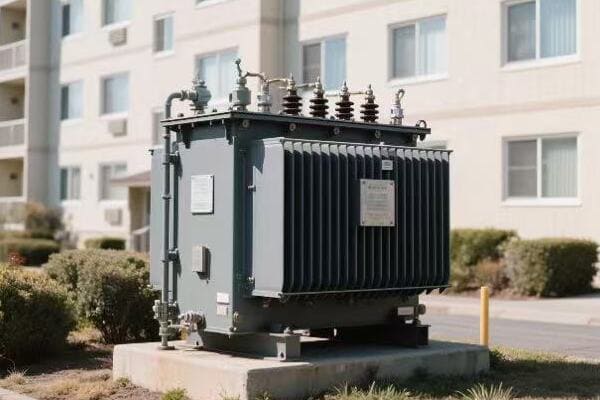
In this comprehensive guide, I’ll walk you through the key differences between pole transformers and other distribution transformer types. We’ll explore their unique features, applications, and how to choose the right one for your project. Whether you’re a seasoned engineer or new to the field, this article will provide valuable insights to help you make informed decisions about distribution transformer selection.
What Is a Pole-Mounted Transformer?
Have you ever looked up at those cylindrical objects attached to utility poles and wondered what they are? These are pole-mounted transformers, but what exactly do they do, and why are they so common in certain areas?
A pole-mounted transformer is a type of distribution transformer installed on utility poles. It steps down high voltage electricity from primary distribution lines to lower voltages suitable for end-user consumption. These transformers are typically used in rural or suburban areas where overhead power lines are common. They’re cost-effective for areas with lower population density and are easier to install and maintain compared to underground systems.
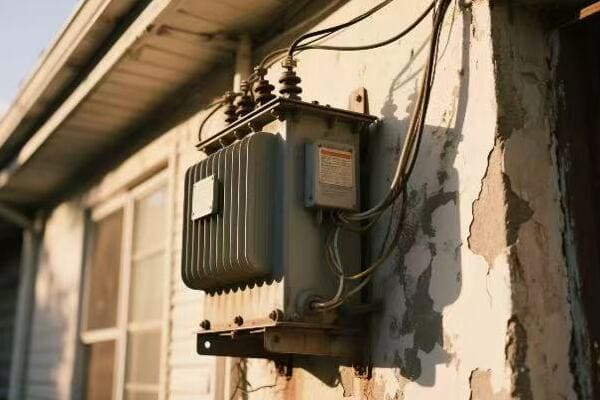
Understanding Pole-Mounted Transformers
Let’s break down the key aspects:
- Basic Function and Design
- Typical Applications
- Voltage Ranges and Capacities
- Advantages and Limitations
- Installation and Maintenance Considerations
Basic Function and Design
Pole-mounted transformers:
- Step down voltage from primary distribution lines
- Typically oil-filled for insulation and cooling
- Housed in a cylindrical tank mounted on a utility pole
I recently worked on a rural electrification project where pole-mounted transformers were crucial in bringing power to remote communities cost-effectively.
Typical Applications
Common uses include:
- Rural and suburban residential areas
- Small commercial zones in less densely populated areas
- Agricultural settings
- Temporary power supply for construction sites
During a recent project in a developing country, we used pole-mounted transformers extensively to rapidly electrify rural villages, showcasing their efficiency in such settings.
Voltage Ranges and Capacities
Typical specifications:
- Primary voltages: 4.16kV to 34.5kV
- Secondary voltages: 120/240V or 277/480V
- Capacities: Usually range from 5 kVA to 167 kVA
Here’s a quick overview of common configurations:
| Primary Voltage | Secondary Voltage | Typical Capacity Range |
|---|---|---|
| 7.2kV | 120/240V | 10 – 50 kVA |
| 14.4kV | 120/240V | 25 – 100 kVA |
| 24.9kV | 277/480V | 75 – 167 kVA |
Advantages and Limitations
Advantages:
- Cost-effective for less densely populated areas
- Easy to install and maintain
- Suitable for quick deployment
Limitations:
- More exposed to weather and potential damage
- Visual impact on landscapes
- Limited capacity compared to larger pad-mounted units
Installation and Maintenance Considerations
Key points:
- Requires sturdy utility poles
- Regular visual inspections are easier due to accessibility
- Maintenance can often be done without power interruption to other customers
Key points about pole-mounted transformers:
- Ideal for overhead distribution systems in less dense areas
- Cost-effective solution for rural and suburban power needs
- Easier to install and maintain compared to underground systems
- Limited in capacity, typically serving smaller loads
- More exposed to environmental factors and potential damage
In my experience, pole-mounted transformers are often the go-to choice for rapid electrification projects in developing regions. I recall a project in Southeast Asia where we used these transformers to quickly bring power to a series of small villages. Their ease of installation and maintenance was crucial in meeting tight project deadlines and budget constraints.
For instance, in a recent project upgrading the power distribution in a rural area prone to flooding, we chose pole-mounted transformers over pad-mounted options. This decision not only saved on installation costs but also ensured that the transformers would remain operational even during flood events, highlighting the importance of considering local environmental factors in transformer selection.
As we move on to discuss the key structural features of pole transformers, keep in mind how these basic characteristics influence their design and functionality. Understanding these aspects will help you appreciate why pole transformers are preferred in certain scenarios over other types of distribution transformers.
Key Structural Features of Pole Transformers?
Have you ever wondered what makes pole transformers uniquely suited for overhead power distribution? Understanding their structural features is crucial for anyone involved in electrical system design or utility management. But what specific design elements allow these transformers to function effectively while mounted high on utility poles?
Pole transformers have distinct structural features designed for overhead mounting and operation. They typically have a cylindrical tank for oil insulation, external cooling fins, high-voltage bushings on top, and low-voltage bushings at the bottom. Their compact design includes integrated lightning arresters and fuses for protection. The mounting bracket is crucial for secure pole attachment, and the overall structure is designed to withstand various weather conditions.
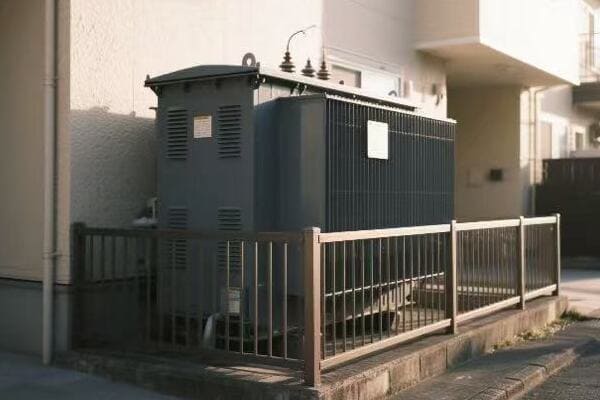
Exploring Pole Transformer Structure
Let’s break down the key structural elements:
- Tank Design and Cooling System
- Bushing Arrangement
- Protection Components
- Mounting System
- Weather-Resistant Features
Tank Design and Cooling System
The core structure:
- Cylindrical tank housing the core and windings
- Filled with mineral oil for insulation and cooling
- External cooling fins or radiators for heat dissipation
I recently inspected a pole transformer that had been in service for over 30 years. Its well-designed cooling system had played a crucial role in its longevity, efficiently managing heat even in extreme weather conditions.
Bushing Arrangement
Critical for power connection:
- High-voltage bushings on top for primary connection
- Low-voltage bushings at bottom for secondary distribution
- Designed for easy connection to overhead lines
During a recent installation project, I noticed how the strategic placement of bushings significantly simplified the connection process and reduced installation time.
Protection Components
Integrated safety features:
- Lightning arresters to protect against surges
- Fuses for overcurrent protection
- Sometimes include load break switches
Here’s a quick overview of protection components:
| Component | Function | Location |
|---|---|---|
| Lightning Arrester | Surge protection | Top of tank |
| Fuse | Overcurrent protection | Near HV bushing |
| Load Break Switch | Manual disconnection | Side of tank |
Mounting System
Crucial for pole installation:
- Robust mounting bracket for secure attachment
- Designed to distribute weight evenly on the pole
- Often includes a platform for additional equipment
Weather-Resistant Features
Designed for outdoor durability:
- Weatherproof seals to prevent moisture ingress
- Corrosion-resistant paint or galvanized finish
- Designed to withstand wind, rain, and temperature extremes
Key points about pole transformer structure:
- Cylindrical tank design optimizes space and cooling
- Bushing arrangement facilitates easy connection to overhead lines
- Integrated protection components enhance reliability
- Robust mounting system ensures secure pole attachment
- Weather-resistant features are crucial for long-term outdoor operation
In my experience, the structural design of pole transformers plays a significant role in their performance and longevity. I recall a project in a coastal area where we specifically chose pole transformers with enhanced corrosion-resistant features. This decision proved invaluable as these units have shown remarkable durability in the harsh, salt-laden environment.
For example, during a recent grid modernization project in a region prone to severe thunderstorms, we focused on pole transformers with advanced surge protection features. The integrated lightning arresters and robust insulation system have significantly reduced outages due to lightning strikes, showcasing how structural features directly impact system reliability.
As we move on to compare pole transformers with pad-mounted units, keep these structural characteristics in mind. Understanding these features will help you appreciate the unique advantages and limitations of pole transformers in different application scenarios.
Pole vs Pad-Mounted Transformers: Core Differences?
Are you weighing the pros and cons of pole-mounted versus pad-mounted transformers for your project? This decision can significantly impact your power distribution system’s efficiency, cost, and aesthetics. But what are the key differences between these two types of transformers, and how do they affect their suitability for different applications?
Pole-mounted transformers are installed on utility poles, ideal for overhead distribution in less dense areas. Pad-mounted transformers are ground-level units, suitable for underground systems in urban settings. Pole transformers are more exposed but cheaper to install, while pad-mounted units offer better aesthetics and protection. Pole units typically have lower capacities (up to 167 kVA) compared to pad-mounted transformers (up to 3000 kVA). The choice depends on factors like location, capacity needs, and installation costs.
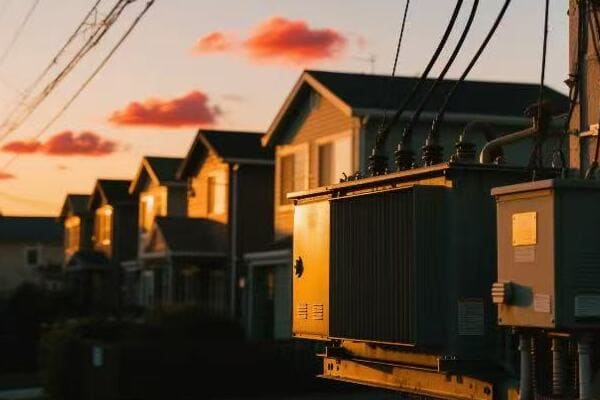
Key Differences Between Pole and Pad-Mounted Transformers
Let’s explore the main distinctions:
- Installation and Location
- Capacity and Size
- Aesthetics and Environmental Impact
- Safety and Accessibility
- Cost Considerations
Installation and Location
Pole-mounted:
- Installed on utility poles, part of overhead systems
- Ideal for rural and less densely populated areas
Pad-mounted:
- Installed on ground-level concrete pads
- Suitable for urban and suburban areas with underground distribution
I recently worked on a suburban development project where we transitioned from pole to pad-mounted transformers as the area became more densely populated, significantly improving the neighborhood’s aesthetics.
Capacity and Size
Pole-mounted:
- Typically range from 5 kVA to 167 kVA
- Compact design due to pole mounting constraints
Pad-mounted:
- Can range from 75 kVA to 3000 kVA or more
- Larger size allows for higher capacities
During a recent industrial park project, we opted for pad-mounted transformers due to their higher capacity, which was crucial for meeting the diverse power needs of multiple businesses.
Aesthetics and Environmental Impact
Pole-mounted:
- More visible, can affect landscape aesthetics
- Part of overhead line systems
Pad-mounted:
- Less visible, can be concealed with landscaping
- Compatible with underground distribution systems
Here’s a quick comparison:
| Aspect | Pole-Mounted | Pad-Mounted |
|---|---|---|
| Visual Impact | High | Low |
| Space Required | Minimal ground space | Larger ground footprint |
| Environmental Resistance | Exposed to elements | Better protected |
Safety and Accessibility
Pole-mounted:
- More exposed to weather and potential damage
- Easier to access for maintenance, but requires working at height
Pad-mounted:
- Better protected from physical damage and weather
- Ground-level access, but may require special tools to open
Cost Considerations
Pole-mounted:
- Generally lower initial installation costs
- May have higher long-term maintenance costs due to exposure
Pad-mounted:
- Higher initial installation costs, especially with underground systems
- Potentially lower long-term maintenance costs due to better protection
Key points about the differences:
- Installation location significantly affects suitability for different areas
- Capacity ranges differ, with pad-mounted offering higher options
- Aesthetics and environmental impact vary greatly between the two
- Safety and accessibility considerations differ due to mounting style
- Cost implications vary for initial installation and long-term maintenance
In my experience, the choice between pole and pad-mounted transformers often comes down to a balance of practical, aesthetic, and economic factors. I recall a project in a historical district where, despite the higher cost, we chose pad-mounted transformers to preserve the area’s visual character. This decision not only met the power needs but also satisfied local preservation requirements.
For instance, in a recent rural electrification project, we initially planned to use pole-mounted transformers throughout. However, for the town center, we switched to pad-mounted units to create a more urban feel and accommodate future underground utility plans. This hybrid approach allowed us to optimize costs while meeting both immediate needs and long-term development goals.
As we move on to discuss underground transformers, keep these differences in mind. Understanding the strengths and limitations of pole and pad-mounted transformers will help you appreciate the unique niche that underground units fill in certain applications.
Underground Transformers vs Pole Units: Space and Safety Trade-Off?
Are you grappling with the decision between underground and pole-mounted transformers for your power distribution project? This choice involves crucial trade-offs in terms of space utilization, safety, and cost. But what specific factors should you consider when weighing these options, and how do they impact your overall system design?
Underground transformers offer superior aesthetics and protection from weather and physical damage, ideal for urban areas with high safety and aesthetic requirements. Pole-mounted units are more cost-effective and easier to maintain, suitable for rural or less dense areas. Underground transformers require more initial investment and complex installation but offer space-saving benefits and enhanced safety. Pole units are more exposed but provide easier access for maintenance and are quicker to install.

Comparing Underground and Pole-Mounted Transformers
Let’s explore the key aspects:
- Space Utilization and Aesthetics
- Safety and Environmental Protection
- Installation Complexity and Costs
- Maintenance and Accessibility
- Long-Term Reliability and Performance
Space Utilization and Aesthetics
Underground transformers:
- Minimal above-ground footprint
- Preserve landscape aesthetics
- Ideal for urban and high-value property areas
Pole-mounted transformers:
- Require no ground space but impact skyline
- More visible, affecting area aesthetics
- Suitable for areas where overhead lines are common
I recently worked on a downtown revitalization project where switching to underground transformers dramatically improved the area’s visual appeal, contributing to increased property values.
Safety and Environmental Protection
Underground transformers:
- Better protected from weather, vandalism, and accidents
- Reduced risk of wildlife interference
- Lower electromagnetic field exposure to the public
Pole-mounted transformers:
- More exposed to weather and potential physical damage
- Higher risk of animal-related outages
- EMF exposure more noticeable in immediate vicinity
During a recent project in a hurricane-prone area, we opted for underground transformers to enhance system resilience against severe weather events.
Installation Complexity and Costs
Underground transformers:
- Higher initial installation costs
- Require excavation and specialized equipment
- Longer installation time
Pole-mounted transformers:
- Lower initial installation costs
- Quicker to install
- Require sturdy pole infrastructure
Here’s a cost comparison based on a recent project:
| Aspect | Underground | Pole-Mounted |
|---|---|---|
| Initial Installation Cost | High | Moderate |
| Installation Time | 3-5 days | 1-2 days |
| Additional Infrastructure | Vault, Drainage | Pole Reinforcement |
Maintenance and Accessibility
Underground transformers:
- Less frequent maintenance due to better protection
- More complex and costly when maintenance is needed
- May require special equipment for access
Pole-mounted transformers:
- Easier visual inspection and access for maintenance
- More frequent maintenance may be necessary
- Can often be serviced without special equipment
Long-Term Reliability and Performance
Underground transformers:
- Generally higher long-term reliability
- Less susceptible to weather-related outages
- Potential issues with water ingress in flood-prone areas
Pole-mounted transformers:
- More exposed to environmental factors
- Quicker to repair and replace if damaged
- May have shorter lifespan in harsh environments
Key points about underground vs pole-mounted transformers:
- Space utilization and aesthetics heavily favor underground units in urban settings
- Safety and environmental protection are generally better with underground transformers
- Installation is more complex and costly for underground units
- Maintenance accessibility is easier for pole-mounted transformers
- Long-term reliability can be higher for underground units in most environments
In my experience, the choice between underground and pole-mounted transformers often involves balancing immediate costs with long-term benefits. I recall a project in a rapidly developing suburban area where we initially installed pole-mounted transformers due to budget constraints. However, as the area grew more densely populated, we faced increasing pressure to convert to underground systems. This transition, while costly, significantly improved the area’s aesthetics and property values, highlighting the importance of considering long-term development plans in initial transformer selection.
For example, in a recent smart city project, we implemented a hybrid approach. We used underground transformers in the city center and commercial districts for aesthetic and safety reasons, while opting for pole-mounted units in less dense residential areas to balance costs. This strategy allowed us to optimize both performance and budget across different zones of the city.
As we move on to discuss which transformer type suits your project, keep these space and safety trade-offs in mind. Understanding these factors will help you make a more informed decision based on your specific project requirements and constraints.
Which Transformer Type Suits Your Project?
Are you feeling overwhelmed by the options available for your power distribution project? Choosing the right transformer type – pole-mounted, pad-mounted, or underground – can significantly impact your project’s success. But how do you determine which type is best suited for your specific needs and constraints?
The choice between pole, pad-mounted, and underground transformers depends on factors like location, budget, aesthetic requirements, and long-term planning. Pole-mounted transformers are ideal for rural areas and quick installations. Pad-mounted units suit suburban environments and offer a balance of accessibility and aesthetics. Underground transformers are best for urban settings with high aesthetic standards and space constraints. Consider factors like installation costs, maintenance accessibility, and future development plans in your decision.
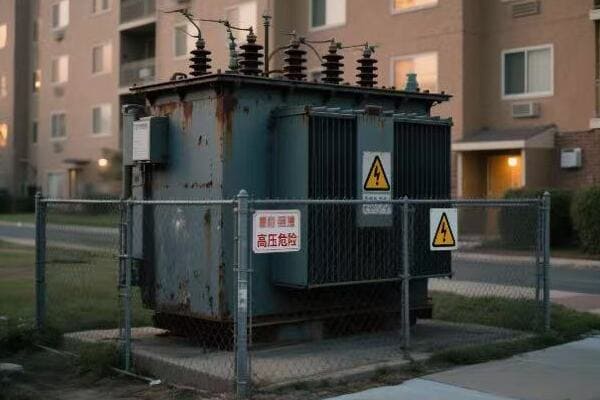
Guiding Your Transformer Selection
Let’s explore the key factors to consider:
- Project Location and Environment
- Budget and Cost Considerations
- Aesthetic and Space Requirements
- Safety and Reliability Needs
- Future Growth and Development Plans
Project Location and Environment
Consider the setting:
- Rural areas: Pole-mounted transformers often ideal
- Suburban zones: Pad-mounted units frequently preferred
- Urban centers: Underground transformers typically best
I recently advised on a project spanning from rural to urban areas. We used pole-mounted transformers in the outskirts, transitioning to pad-mounted in suburban areas, and underground units in the city center, optimizing for each environment.
Budget and Cost Considerations
Evaluate both initial and long-term costs:
- Pole-mounted: Lowest initial cost, higher maintenance
- Pad-mounted: Moderate installation cost, balanced maintenance
- Underground: Highest initial cost, lowest long-term maintenance
During a recent municipal project with a tight budget, we initially chose pole-mounted transformers but designed the system to allow for future upgrades to pad-mounted units as funds became available.
Aesthetic and Space Requirements
Assess visual impact and space constraints:
- Pole-mounted: Most visible, minimal ground space
- Pad-mounted: Less visible, requires some ground space
- Underground: Least visible, no above-ground space needed
Here’s a quick comparison based on aesthetic and space factors:
| Transformer Type | Visual Impact | Ground Space Required | Suitable for |
|---|---|---|---|
| Pole-mounted | High | Minimal | Rural, open areas |
| Pad-mounted | Moderate | Moderate | Suburban, commercial |
| Underground | Low | None (above ground) | Urban, high-value areas |
Safety and Reliability Needs
Consider environmental and safety factors:
- Pole-mounted: More exposed, suitable for areas with low vandalism risk
- Pad-mounted: Better protected, good for areas with moderate safety concerns
- Underground: Best protected, ideal for high-security or severe weather areas
Future Growth and Development Plans
Plan for the long term:
- Consider potential area development and population growth
- Evaluate future power demand increases
- Assess likelihood of transitioning to underground utilities
Key points for selecting the right transformer type:
- Match the transformer type to the specific environment and location
- Balance initial costs with long-term maintenance expenses
- Consider aesthetic impact and available space
- Evaluate safety requirements and environmental factors
- Factor in future development and potential system upgrades
In my experience, successful transformer selection often involves looking beyond immediate needs to consider long-term implications. I recall a project in a rapidly growing suburban area where we initially installed pad-mounted transformers. However, we designed the system with the capability to easily transition to underground units as the area developed, saving significant costs in the long run.
For instance, in a recent resort development project, we faced a unique challenge of balancing aesthetics with practicality. We opted for a combination of underground transformers in high-visibility areas near guest facilities and pad-mounted units in less frequented service areas. This approach allowed us to maintain the resort’s visual appeal while managing costs effectively.
As we move on to compare different brands offering these transformer types, remember that the right choice depends on a careful analysis of your specific project requirements, budget constraints, and long-term goals. The best transformer type for your project is one that not only meets your current needs but also aligns with your future vision.
Brand Comparison: Who Offers the Best Pole, Pad, and Underground Units?
Are you struggling to choose between different transformer brands for your project? With numerous manufacturers offering pole, pad-mounted, and underground transformers, selecting the right one can be overwhelming. But how do top brands compare in terms of quality, features, and suitability for different applications?
Leading transformer brands include ABB, Siemens, CHBEB, and SUNTEN, each with strengths in different types. ABB excels in high-efficiency pole and pad-mounted units. Siemens offers advanced smart grid features across all types. CHBEB provides cost-effective pole transformers popular in developing markets. SUNTEN specializes in compact pad-mounted and underground units for urban applications. The best choice depends on specific project requirements, regional standards, and budget considerations.
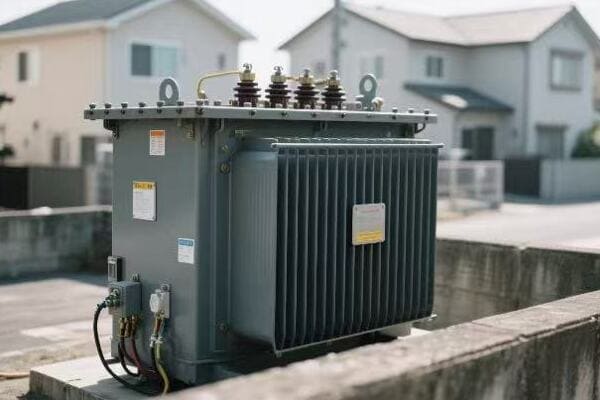
Analyzing Top Transformer Brands
Let’s examine the strengths of leading manufacturers:
- ABB
- Siemens
- CHBEB
- SUNTEN
- Factors to Consider in Brand Selection
ABB
Strengths and specializations:
- High-efficiency pole and pad-mounted transformers
- Advanced monitoring and control systems
- Strong presence in North American and European markets
I recently worked on a smart grid project where ABB’s pole-mounted transformers with integrated monitoring capabilities significantly improved network reliability and efficiency.
Siemens
Notable features:
- Comprehensive range across all transformer types
- Focus on smart grid integration and IoT connectivity
- Strong R&D in eco-friendly insulation materials
During a recent urban redevelopment project, Siemens’ underground transformers with advanced remote monitoring features proved invaluable in managing a complex distribution network.
CHBEB
Key advantages:
- Cost-effective pole transformer solutions
- Strong presence in developing markets
- Rapid customization and delivery capabilities
Here’s a comparison of these top brands:
| Brand | Key Strength | Best For | Notable Feature |
|---|---|---|---|
| ABB | Efficiency | High-performance needs | Advanced monitoring |
| Siemens | Smart technology | Urban smart grids | IoT integration |
| CHBEB | Cost-effectiveness | Developing markets | Quick customization |
| SUNTEN | Compact design | Space-constrained areas | Low noise operation |
SUNTEN
Distinctive features:
- Specializes in compact pad-mounted and underground units
- Low noise operation ideal for urban settings
- Strong focus on energy efficiency in distribution transformers
I recently oversaw a project in a densely populated urban area where SUNTEN’s compact, low-noise underground transformers were crucial in meeting strict city regulations and space constraints.
Factors to Consider in Brand Selection
When choosing a transformer brand, consider:
- Compliance with regional standards and certifications
- After-sales support and spare parts availability
- Total cost of ownership, including efficiency and maintenance
- Compatibility with existing infrastructure
- Specific features required for your project (e.g., smart grid capabilities)
Key points about top transformer brands:
- ABB leads in efficiency and monitoring technology
- Siemens offers comprehensive smart grid solutions
- CHBEB provides cost-effective options, especially for pole transformers
- SUNTEN excels in compact, urban-friendly designs
- Brand selection should align with specific project needs and regional requirements
In my experience, choosing the right brand often involves balancing technical specifications, cost, and long-term support. I’ve seen cases where a less globally recognized brand like CHBEB was the perfect fit due to their ability to provide rapid customization and local support in developing markets.
For example, in a recent project upgrading the power distribution in a rapidly growing industrial zone, we chose a mix of Siemens pad-mounted transformers for the main areas and CHBEB pole-mounted units for the outskirts. This combination allowed us to leverage Siemens’ advanced technology for critical applications while benefiting from CHBEB’s cost-effectiveness and flexibility in less demanding areas.
Remember, the best brand for your project depends on a careful analysis of your specific requirements, budget constraints, and long-term operational needs. Don’t hesitate to request detailed specifications, case studies, and even site visits or virtual tours of manufacturing facilities when making your decision.
Conclusion
Choosing the right transformer type and brand is crucial for optimizing your power distribution system. Consider factors like location, budget, aesthetics, and future growth when selecting between pole, pad-mounted, and underground transformers. Evaluate top brands based on their strengths and your specific project needs. Remember, the best choice balances immediate requirements with long-term performance and cost-effectiveness.
Remember, at chbeb-ele, we’re not just sharing information – we’re empowering you to be part of the solution in creating a secure, clean, and efficient energy future. Let’s continue this journey together.
Recent Post
Quick Message
Request A free quote
We'd like to work with you
- +86 15558785111
- chbebgroup@chbebpower.com
- +86 15558785111
What We Do
CHINA BEI ER BIAN (CHBEB) GROUP, with 218 million in registered capital, originated from Beijing Beierbian Transformer Group. Headquartered in Beijing for R&D, it operates major production bases in Nanjing and Yueqing, producing high-quality products.
Latest Post
Latest Product
Contact Us
- +86 15558785111
- chbebgroup@chbebpower.com
- +86 15558785111
BeiJing
No 3,RongJing East Road,BeiJing Economic Technological Development Area,BeiJing,China
JiangSu
No 7️Xiangfeng Road,Jiangning,NanJing,JiangSu,China
WenZhou
No.211, Wei 16 Road, Industrial Zone, Yueqing, Wenzhou, Zhejiang, China.
XiangYang Industrial Zone ,YueQing,WenZhou,ZheJiang,China

